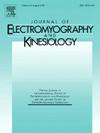Energetic and neuromuscular impact of running on even or uneven surfaces in standardized laboratory conditions
IF 2.3
4区 医学
Q3 NEUROSCIENCES
引用次数: 0
Abstract
Purpose
We examine the energetic and neuromuscular effects of running on even (E-T) and uneven terrains (UE-T) by creating smooth and rough conditions on a standardized circuit.
Methods
Ten adults (age 32.1 ± 7.6 years, body mass 62.2 ± 7 kg, height 167.5 ± 4.2 cm) ran on an ‘iterative-8-shaped’ path. For UE-T, solid hemispheres were fixed to a perforated mat, while for E-T, visible marks guided foot placement. Participants performed two 6-min trials on both terrains in a counterbalanced order, maintaining consistent running patterns and low-intensity speed with a metronome to guide step frequency. This ensured consistency in the timing and positioning of foot placement between the two conditions. Cardio-metabolic parameters were measured continuously, and muscle activation was recorded from six leg muscles using surface EMG.
Results
The analysis showed significantly higher cardio-metabolic responses in UE-T compared to E-T, with increases in oxygen cost (+18 %), energy cost (+23 %), respiratory frequency (+7%), ventilation (+19 %), heart rate (+10 %), and RPE (+50 %) (all p < 0.05). Electromyographic activation of the tibialis anterior (+22 %) and peroneus longus (+10 %) also increased in UE-T.
Conclusions
These findings indicate that running on uneven terrain demands more energy and greater activation of ankle stabilizers, as required in off-road and trail running.
在标准化的实验室条件下,在平坦或不平坦的表面上跑步对能量和神经肌肉的影响
目的:我们通过在标准化赛道上创造光滑和粗糙的条件,研究在平坦(E-T)和不平地形(UE-T)上跑步对能量和神经肌肉的影响。方法10例成人(年龄32.1±7.6岁,体重62.2±7 kg,身高167.5±4.2 cm)按“迭代8型”路径跑步。对于UE-T,实心半球固定在穿孔垫上,而对于E-T,可见标记引导足部放置。参与者在两个地形上以平衡的顺序进行两次6分钟的试验,保持一致的跑步模式和低强度的速度,并使用节拍器来指导步频。这确保了两种情况下脚部放置的时间和位置的一致性。连续测量心脏代谢参数,并使用表面肌电图记录六块腿部肌肉的肌肉激活情况。结果分析显示,与E-T相比,UE-T组的心脏代谢反应明显更高,氧耗增加(+ 18%),能量消耗增加(+ 23%),呼吸频率增加(+7%),通气量增加(+ 19%),心率增加(+ 10%),RPE增加(+ 50%)(p <;0.05)。胫骨前肌(+ 22%)和腓骨长肌(+ 10%)的肌电图激活也在UE-T中增加。这些发现表明,在不平坦的地形上跑步需要更多的能量和更大的踝关节稳定器的激活,正如越野和越野跑所需要的那样。
本文章由计算机程序翻译,如有差异,请以英文原文为准。
求助全文
约1分钟内获得全文
求助全文
来源期刊
CiteScore
4.70
自引率
8.00%
发文量
70
审稿时长
74 days
期刊介绍:
Journal of Electromyography & Kinesiology is the primary source for outstanding original articles on the study of human movement from muscle contraction via its motor units and sensory system to integrated motion through mechanical and electrical detection techniques.
As the official publication of the International Society of Electrophysiology and Kinesiology, the journal is dedicated to publishing the best work in all areas of electromyography and kinesiology, including: control of movement, muscle fatigue, muscle and nerve properties, joint biomechanics and electrical stimulation. Applications in rehabilitation, sports & exercise, motion analysis, ergonomics, alternative & complimentary medicine, measures of human performance and technical articles on electromyographic signal processing are welcome.

 求助内容:
求助内容: 应助结果提醒方式:
应助结果提醒方式:


